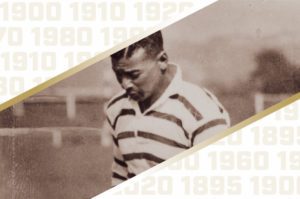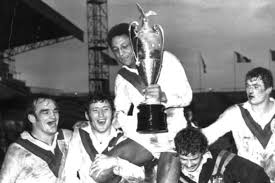Growing up in Cardiff in the 1950s, Clive Sullivan’s ambition to become a star rugby player was hampered by two issues.

As a teenager, he was in and out of hospital undergoing operations on his legs and arms, causing doctors to think he would never become an athlete. And even without this disadvantage, his chances of playing for Wales at rugby union were zero. It was an open secret that no black player would ever be selected for Wales’ national team. Clive had to look elsewhere to fulfil his ambitions.
At first he tried Bradford Northern but they showed little interest and he joined the army. While stationed in Catterick in North Yorkshire he played in a trial match for Hull and scored a hat-trick of tries. He would become one of the greatest players in the club’s history, scoring 250 tries. When he discovered in 1974 that he no longer figured in Hull’s plans, he moved east to join Hull KR where he stayed for seven years and scored another 118 tries. He became such an icon to his adopted home city that the main arterial road into Hull was renamed Clive Sullivan Way.
But these weren’t his only achievements. In 1972 he was appointed captain of the Great Britain rugby league team, and later that year he not only scored an unforgettable length-of-the-field try but he also became the last British player to hold the World Cup trophy aloft. But Clive was not only the first black player to captain Great Britain, he was also the first black athlete in any sport to skipper a British national sporting team. He had not only achieved his boyhood dream, he had also become a pioneer for the whole of British sport.
Rugby league had been founded on the principle of equality for all players and the game’s emphasis on merit was highlighted by the emergence of black players. The first black athlete to play professional rugby league seems to have been Lucius Banks, who signed for Hunslet in 1912. Banks, a US soldier, was spotted playing American football by a Hunslet official in New York on business. In 1913 Barrow signed James Peters, a black dockworker from Plymouth, whose five England caps between 1906 and 1908 made him the sole black player to play rugby union for England until 1988. Peters signed as his career was winding down and, despite a move to St Helens, his career effectively ended with the outbreak of World War One.
During the inter-war years black players made their presence felt as professional players. In 1935 Wigan stand-off George Bennett made the first of three appearances for Wales in their first-ever match against France. Oldham loose-forward Alec Givvons missed only two of Wales’s eight matches between 1936 and 1939. In 1937 Broughton’s Jimmy Cumberbatch became the first black player to be selected for England when he scored two tries against France at Thrum Hall. His brother Val played for Barrow and he scored a try on his debut for England against France in Paris in 1938. The Cumberbatch brothers played for England fully forty years before Viv Anderson became the first black player to play soccer for England, and this was also a time when the ‘colour bar’ prevented black boxers from fighting for British championship belts.
The most outstanding black player to emerge in the 1930s was, like Bennett and Givvons, born in Wales. Roy Francis signed for Wigan as a seventeen year-old in 1936 but was transferred to Barrow after just 12 matches by the club’s new manager Harry Sunderland because, Francis believed, of the colour of his skin. After an outstanding war-time career, he became the first black player to play for Great Britain in 1947. In 1949 he moved to Hull, where he became probably the first black person to coach a professional sports team in Britain. He turned a mediocre side into championship winners, took them to Wembley twice, and brought to the game motivational techniques, scientific fitness regimes, and tactical innovation. He then moved to coach Leeds in 1963, and created one of the club’s greatest teams.
Black players become household names in the game in the 1950s. Leeds-born Cec Thompson, played for Great Britain in 1951 and in 1960 was appointed as coach of the Barrow club. In 1953 Wigan signed winger Billy Boston, who was such a phenomenon that he was selected for the 1954 British tour of Australia after just six Wigan matches, becoming the then youngest-ever tourist. The following year Johnny Freeman left Wales to make a career, and a life, in Halifax where he became arguably the club’s best-ever winger.
Colin Dixon, Frank Wilson, Terry Michael, and many others followed in his footsteps in the 1960s. But few matched the heights reached by Clive Sullivan, who in 1972 became the first black captain of a major British sports team when he led the British side to victory in the World Cup Final. Clive Sullivan had proved that the founders of the Northern Union were correct – the only attributes that mattered in rugby league were talent and commitment.
This is an exclusive extract from Tony Collins’ new book ‘Rugby League: A People’s History’ which will be published on 29 August by Scratching shed Publications. You can order a copy here and follow the author on Twitter via @collinstony.

